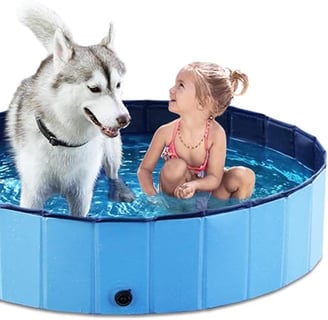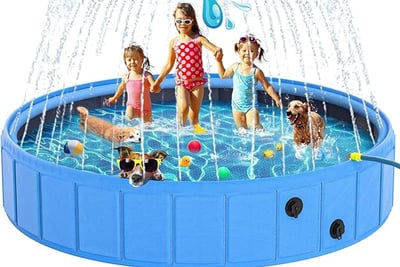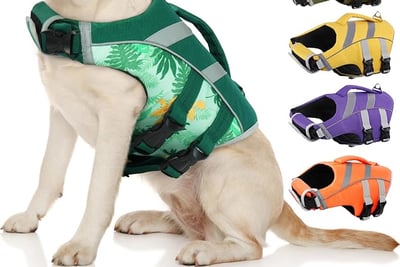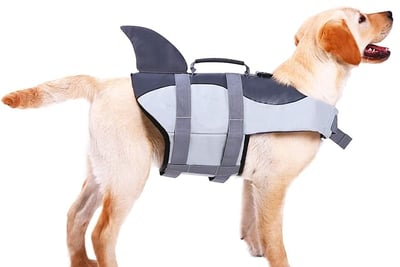Safe & Fun Ways to Introduce Your Dog to Swimming
8 min read


Understanding Your Dog's Readiness for Swimming
Before embarking on the journey of introducing your dog to swimming, it is crucial to assess their readiness. Not all dogs have the same affinity for water, and some breeds excel in aquatic environments due to their natural swimming abilities. Breeds such as Labradors, Golden Retrievers, and Newfoundlands are often known for their enthusiasm in water. These dogs possess physical attributes and instincts that make them well-suited for swimming, while others may be more reluctant or apprehensive. Understanding your dog’s breed can provide insights into their potential enjoyment of swimming.
In addition to breed characteristics, observing your dog’s behavior can also reveal their readiness for swimming. Signs that your dog may enjoy swimming include a strong curiosity about water, eagerness to enter shallow areas, and playful behavior around water features, even if it is just puddles or sprinklers. Conversely, if your dog displays signs of fear or anxiety when approached by water, it may be indicative of a lack of readiness. Monitor their reactions closely, as these reactions are critical indicators of whether swimming will be a positive experience for them.
It is equally important to consider your dog’s age, health status, and temperament. Puppies, for example, may require more gradual introductions to swimming compared to adult dogs. Older dogs or those with specific health issues, such as joint problems or respiratory conditions, may not be suited for swimming activities. Assessing your dog’s overall temperament—whether they are more timid or adventurous—will also guide you in planning their introduction to swimming. Additionally, any previous experiences your dog has had with water, whether positive or negative, can significantly influence their behavior. A positive experience, like a splash in a kiddie pool, may foster confidence, while a negative experience could lead to lasting apprehension.
Choosing the Right Location for Your Swim Introduction
When considering introducing your dog to swimming for the first time, selecting an appropriate location is crucial for their safety and enjoyment. Not all bodies of water are suitable for canine swimming, and understanding the various environments can help ensure a positive experience. Calm lakes, dog-friendly pools, and shallow sandy beaches are ideal choices for this purpose. Each offers distinct benefits that cater to different dog breeds and personalities.
Calm lakes provide a serene environment where dogs can acclimate to water without the distractions often found in busier areas. Look for spots that feature gentle slopes and shallow water that allows dogs to wade in comfortably. Additionally, ensure the water is clean and safe, free from any pollutants or toxic algae that could pose a health risk. Be mindful of local wildlife, as areas near natural bodies of water may host animals that could intimidate or distress your dog.
Dog-friendly pools offer a controlled atmosphere, making them an excellent option for introducing dogs to swimming. Typically warmer and cleaner than natural water sources, these pools have specific areas designated for canines, allowing for easy access and monitoring. Ensure the pool has gentle entry points, such as ramps or steps, to facilitate a positive first experience. Also, keep an eye on your dog and provide ample breaks when needed.
Shallow sandy beaches can also be another fun option for swimming introductions. The beach's gradual slope allows dogs to ease into the water, making it easier for them to feel comfortable. Always check if the beach is dog-friendly and keep a watchful eye on tides, as well as any potential currents, to ensure your dog's safety. Each of these locations provides a distinct opportunity for your dog to explore and enjoy the water, making swimming an enjoyable activity for both of you.
Preparing Your Dog for Their First Swim
Introducing your dog to swimming requires careful preparation to ensure a positive and safe experience. One of the first steps is to gather the necessary gear. A flotation device designed for dogs is often recommended, particularly for breeds that are either inexperienced swimmers or are known to struggle with buoyancy. These dog life jackets provide additional security and peace of mind, both for you and your pet. Additionally, a sturdy leash can be beneficial for maintaining control in the water, especially in the initial stages of their introduction to swimming.
While flotation devices are vital, optional swim suits can also make the experience more enjoyable for your dog. Swim wear can help keep them warm in cooler waters and protect their skin from potential irritants. Choose a suit that fits comfortably and allows for easy movement, as this will help your dog feel more at ease in the water.
Before your dog takes their first plunge, acclimatizing them to water is essential. Start by introducing them to shallow areas, where they can gradually adjust to the sensation of being in water. Use their favorite toys to encourage engagement and playfulness. Fetching a soft, water-friendly toy can turn a potentially intimidating experience into a fun and enjoyable game. Additionally, practicing basic commands, such as "sit" and "stay," on the shore will reinforce their training and help establish a sense of trust between you and your dog.
Patience is key during this process; some dogs may take longer to feel comfortable than others. Progressively venturing into deeper water should only be attempted once your dog is confident in the shallow end. Through thoughtful preparation and gentle guidance, your dog's first swim can be a delightful learning experience that enhances their enjoyment of water activities in the future.
Introducing Your Dog to Water Gradually
Introducing a dog to water can be a rewarding experience if approached with care and patience. The primary objective is to ensure your dog feels comfortable and secure as they develop their swimming skills. Gradual exposure to water is essential for reducing anxiety and fostering a positive association with this new environment.
Start the introduction process in a shallow area, such as a kiddie pool or a calm beach setting, where the water depth is minimal. Allow your dog to explore this space at their own pace, giving them the opportunity to acclimate to the sensations of wetness without feeling overwhelmed. At this stage, it is crucial to remain calm and encouraging, as your demeanor can significantly impact your pet's comfort level.
Utilizing play can be a highly effective way to engage your dog and encourage them to enjoy their swimming experience. Bringing their favorite toys into the water can entice them to enter more willingly. It’s also helpful to bring along some treats to reward your dog for any brave attempts they make at wading or entering the water. Positive reinforcement is key; every small achievement should be met with enthusiasm and praise. This establishes a fun atmosphere, which is particularly important for fostering confidence in the water.
Another method to promote a gradual introduction to swimming is to participate in the water alongside your dog. Your presence can provide reassurance and act as an invitation for them to join you. It is important to maintain a relaxed demeanor and avoid rushing them into deeper waters until they are ready. Monitor your dog's reactions closely, and if they display signs of distress or discomfort, pause and give them space to adjust. With time and patience, most dogs can learn to enjoy swimming, turning a potentially daunting experience into a beloved activity.
Recognizing and Addressing Your Dog's Fears
It is not uncommon for dogs to exhibit apprehension when introduced to swimming. Understanding the signs of fear or stress in your canine companion is crucial for fostering a positive experience. Common indicators of anxiety may include whining, a reluctance to enter the water, or even aggressive behavior towards the environment or people. Recognizing these signs early on allows for timely intervention and support.
When a dog displays signs of fear, it is essential to respond with patience and empathy. One effective strategy is to create a safe and controlled environment for your dog. Start by familiarizing your pet with water in a calm setting, such as a shallow pool or a beach where the water is gently lapping at the shore. This gradual approach can help alleviate some of the stress and provide your dog with the opportunity to explore at their own pace.
Incorporating positive reinforcement techniques is vital to encouraging your dog. Use treats, praise, and toys to create positive associations with water. For instance, reward your dog for simply approaching the water, and gradually increase the level of engagement as they become more comfortable. This step-by-step exposure can significantly reduce anxiety in dogs that are unwilling to enter the water initially.
Moreover, consider using socialization with other dogs that are already comfortable swimming. Dogs often learn from one another, and a confident swimming companion can help your dog feel more secure in the water. Ensure that the experience is enjoyable and stress-free, promoting a supportive environment where your dog can thrive.
Ultimately, by recognizing your dog's fears and employing gentle strategies to address them, you can foster a positive introduction to swimming, ensuring that both you and your pet can enjoy this refreshing activity together.
Safety Tips for Swimming with Your Dog
Ensuring the welfare of your dog during swimming activities is crucial. One of the primary safety tips is to supervise your dog at all times while they are in or around water. Even the strongest swimmers can get into trouble unexpectedly, so maintaining a close watch is essential. Keep an eye on their behavior and surroundings, as this will help you quickly respond to any issues that may arise.
It is equally important to be vigilant for signs of fatigue. Dogs, like humans, can tire out quicker than anticipated, especially in water. Signs of fatigue may include heavy panting, decreased activity, or difficulty staying afloat. If you notice any of these signs, it is wise to guide your dog back to the shore or pool’s edge to allow them to rest. This vigilance ensures that your dog remains safe and enjoys their swimming experience.
Hydration is another critical aspect of swimming safety. Even while swimming, dogs can become dehydrated, especially under the sun. Providing access to fresh water before, during, and after swim sessions will help keep your pet hydrated. Always encourage your dog to take breaks and drink water to prevent overheating and exhaustion.
In the unfortunate event of an emergency, being prepared can make a significant difference. Familiarize yourself with basic first aid for dogs. For instance, if your dog appears to panic or become distressed in the water, calmly assist them back to safety. Do not dive in after them unless absolutely necessary, as this might escalate their panic. It is also vital to be aware of water hazards such as strong currents or sharp objects that could pose a risk. A well-prepared pet owner can enhance their dog's safety while swimming and reinforce a positive experience in the water.
Making Swimming a Fun and Regular Activity
Once your dog has acclimated to the water, swimming can transform into a rewarding and enjoyable activity for both of you. Making swimming a regular inclusion in your dog's routine not only reinforces their comfort with water but also offers numerous benefits for their physical and mental well-being. To ensure that swimming sessions remain fun, consider incorporating games and toys that stimulate your dog's natural instincts.
Engaging in water-based games, such as fetch or frisbee, can significantly enhance the experience. These activities not only encourage your dog to swim but also promote exercise, which is vital for maintaining a healthy weight and preventing obesity-related issues. By introducing floating toys or balls designed for water play, you can easily keep your canine companion entertained and actively engaged during swim time. This fosters a positive association with swimming, which can develop into a lifelong love of the water.
Additionally, socializing your dog with other friendly, well-behaved dogs while swimming can boost their confidence and bring a new level of enjoyment to the activity. Arranging regular swim playdates with fellow dog owners can create opportunities for your dog to interact with peers in a stimulating environment. Not only does this add excitement to their swimming experience, but it also helps to build essential social skills and promote good behavior around other dogs.
Furthermore, swimming serves as an excellent low-impact exercise option, ideal for dogs of all ages, especially those with joint issues or recovering from injury. Regular swimming sessions contribute to overall fitness and mobility while reducing stress levels. Ultimately, by making swimming a consistent and enjoyable activity in your dog's life, you are not only facilitating fun but also advocating for their health and well-being.











